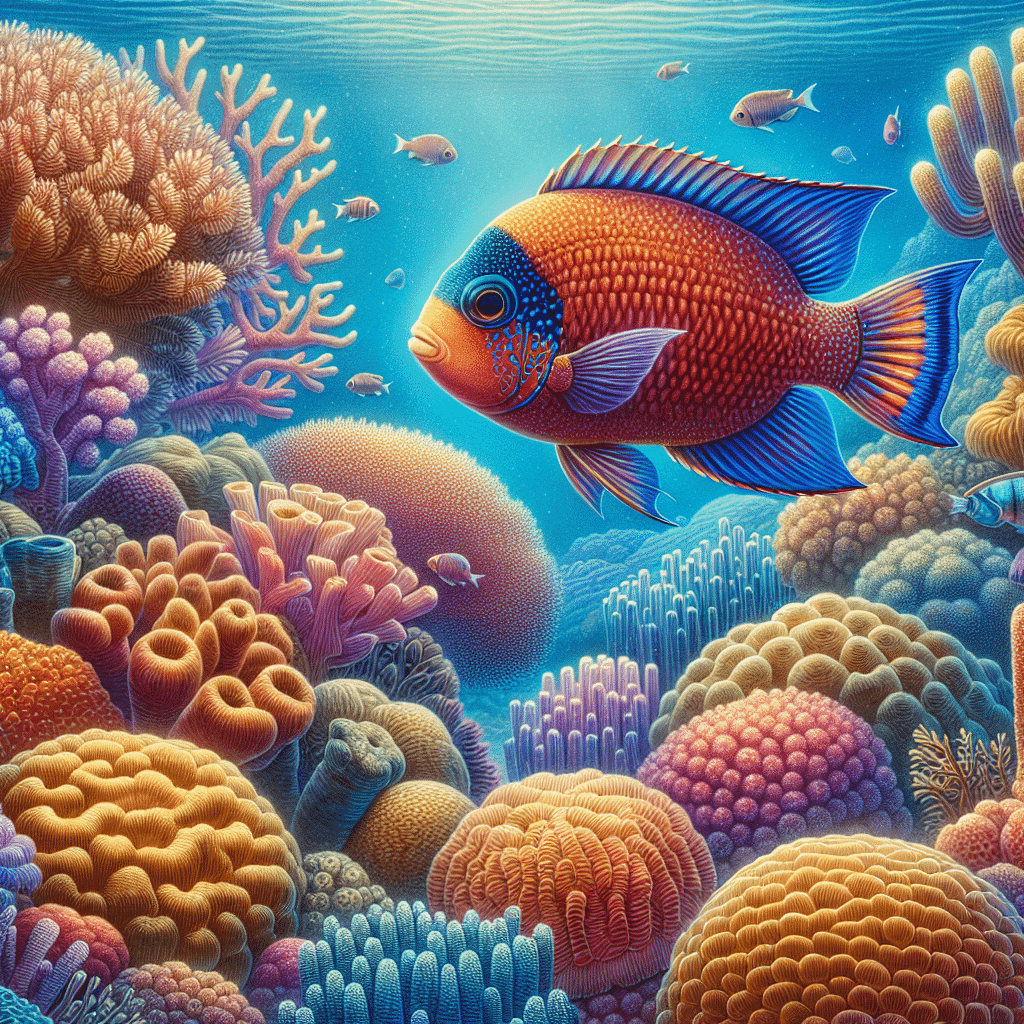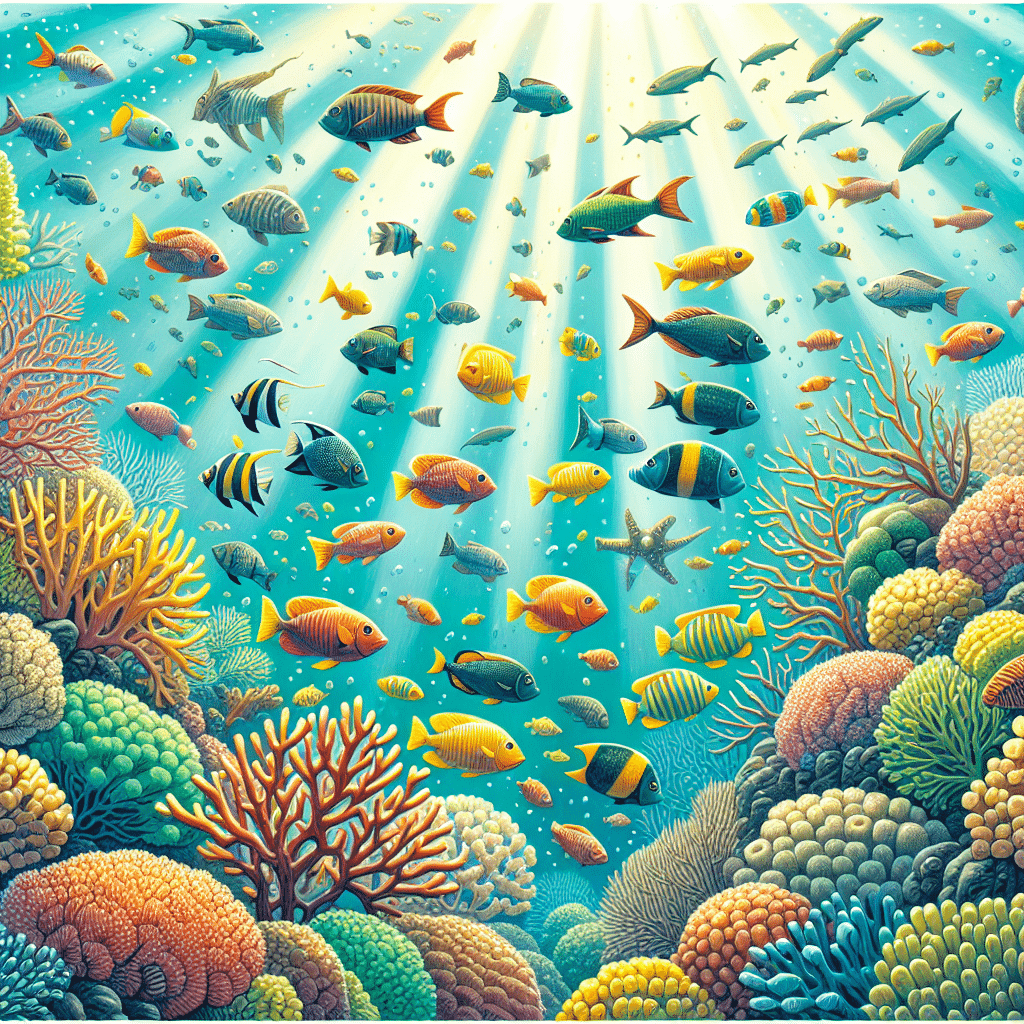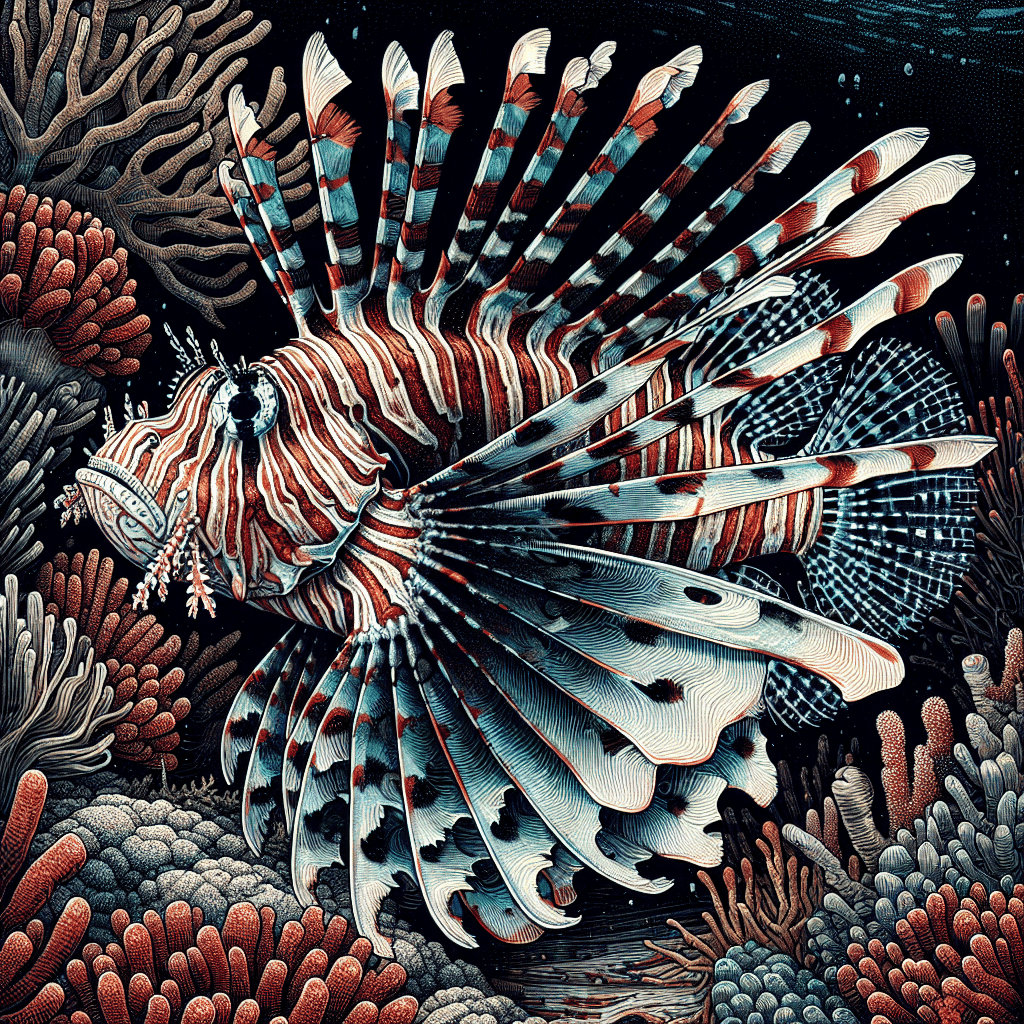The World of Damselfish
Introduction to Damselfish
I’ve always been fascinated by the vibrant world of damselfish. These little gems belong to the family Pomacentridae, which includes around 420 species and is one of the most abundant families of tropical reef fishes. Known for their small size and bright colors, damselfish are a favorite among aquarium enthusiasts like me. Their range of colors includes red, orange, yellow, blue, black, and white, making them a lively addition to any reef tank.
Damselfish typically have deep, compressed bodies and can range in size from five to 36 cm, with most being less than a foot long. Their unique physical characteristics, such as ctenoid scales and forked tails, set them apart from other marine fish. These features not only contribute to their beauty but also play a role in their behavior and interactions within their habitat.
Diversity in Damselfish Species
The diversity within damselfish species is truly remarkable. With approximately 28 genera and 335 species, there’s a lot to explore. Most damselfish thrive in marine environments, but a few can adapt to brackish or freshwater settings. They primarily inhabit tropical and subtropical waters of the Atlantic, Indian, and Pacific Oceans.
Here’s a quick overview of some notable species:
| Species Name | Size (cm) | Color Variations | Habitat |
|---|---|---|---|
| Pomacentrus amboinensis | Up to 10 | Blue, yellow | Coral reefs |
| Chrysiptera starcki | Up to 8 | Yellow, blue | Lagoon and reef areas |
| Clownfish (Amphiprioninae) | Up to 18 | Orange with white bands | Anemones and reefs |
| Blue Tang (Paracanthurus) | Up to 30 | Blue with yellow tail | Coral reefs |
These fish are not only known for their stunning appearances but also for their territorial and sometimes aggressive behavior. This can be quite entertaining to watch in a tank environment. Their diverse adaptations and behaviors make damselfish a fantastic topic for both casual observation and serious study.
If you’re interested in learning more about other types of marine fish that could complement your reef tank, you might want to check out species like the clownfish or the blue tang.
Damselfish Behavior and Reproduction
Antipredator Behavior in Damselfish
When it comes to surviving in the wild, damselfish have some interesting strategies to deal with predators. I’ve learned that these little fish can actually modify their escape responses depending on the size of the predator, especially in high-risk situations. This flexibility shows how well they can assess their environment and react accordingly. For instance, when faced with larger threats, damselfish may take more decisive actions to evade capture. Their ability to adjust their behavior based on risk levels demonstrates a fascinating form of plasticity in risk assessment (Journal of Experimental Marine Biology and Ecology).
Interestingly, damselfish have a unique mechanism involving chemical cues. When they are preyed upon, they release chemical alarm signals that not only warn other fish but also attract secondary predators. This can actually improve their chances of escaping, as it creates confusion and alters the dynamics of predator interactions. In studies, it was noted that this tactic can increase their escape chances by 35-40% (Royal Society Publishing). It’s pretty cool how nature works like that!
Reproductive Strategies of Damselfish
When it comes to breeding, damselfish have their own set of strategies to ensure the survival of their young. They usually engage in a behavior called “nesting.” Male damselfish are particularly dedicated parents. They create nests by clearing areas of algae and debris on the substrate. Once the female lays her eggs in the nest, the male takes on the role of protector, guarding the eggs until they hatch.
Another interesting aspect is their use of chemical cues during reproduction. Just like with their antipredator behavior, chemical signals play a role in attracting mates. The presence of certain chemicals can indicate a female’s readiness to spawn, facilitating successful mating.
Here’s a quick comparison of some characteristics of damselfish reproductive behavior:
| Characteristic | Description |
|---|---|
| Nesting | Males clear debris to create nests |
| Parental Care | Males guard eggs until hatching |
| Chemical Cues | Used for attracting mates |
Understanding these behaviors can enhance my appreciation for damselfish in my reef tank. It’s intriguing to see how their natural instincts play out, and it gives me more insight into their care and maintenance in an aquarium setting. If you’re looking to dive deeper into the aquatic world, consider exploring more about fellow marine inhabitants like clownfish and tangs.
Damselfish in the Wild
Habitat and Distribution
I find it fascinating that damselfish can be found in diverse environments. Most species thrive in marine waters, specifically around coral reefs. They inhabit tropical, subtropical, and temperate zones, often residing at depths of up to 655 feet. The majority of damselfish species are distributed throughout the Indo-west and central Pacific regions, with some populations in the Atlantic Ocean as well (Animal Diversity Web, A-Z Animals).
| Region | Habitat Type |
|---|---|
| Indo-West Pacific | Coral Reefs |
| Atlantic Ocean | Coral Reefs |
| Brackish/Freshwater | Some Species |
Unique Adaptations of Damselfish
Damselfish have some incredible adaptations that help them thrive in their native habitats. They are primarily omnivorous, consuming a diet of both plant and animal matter. This versatility allows them to adapt to different food sources found in their coral reef environments.
One of the more interesting behaviors I’ve observed is their tendency to be territorial, especially during breeding seasons. They defend their nests vigorously against potential threats, which helps ensure the survival of their young. Additionally, they can exhibit filial cannibalism, consuming their own eggs, which may seem harsh but can be a strategy to reduce competition for resources (A-Z Animals).
Damselfish also have various predators, including sharks and larger fish like groupers and snappers. This predator-prey dynamic shapes their behavior and adaptations, making them resilient in their environments. Overall, the combination of their habitat preferences and unique adaptations makes damselfish a captivating subject for anyone interested in marine life.
If you’re curious about other marine fish species, you might want to check out articles on clownfish, tang, and grouper.
Popular Damselfish Species
When it comes to damselfish, two species that stand out in the aquarium hobby are Pomacentrus amboinensis and Chrysiptera starcki. Both of these fish not only have unique characteristics but also play important roles in their ecosystems. Let me share some details about each one.
Pomacentrus amboinensis
Pomacentrus amboinensis, also known as the Ambon damselfish, is a fascinating species found primarily in the Western Pacific. This fish can grow up to 9 cm in length and often lives in small groups. Typically, one mature male will guard a nest site on the seafloor, while multiple females surround him. Interestingly, females tend to stay put once they’ve settled, and new juveniles can easily join these established groups.
Another intriguing aspect of P. amboinensis is its protogynous nature, meaning it starts life as a female and can transition into a male as it reaches sexual maturity. Some males even maintain juvenile appearances to sneak into the harems of dominant males. This adaptability makes them a unique choice for reef tank enthusiasts.
| Characteristic | Details |
|---|---|
| Maximum Size | 9 cm |
| Habitat | Western Pacific |
| Social Structure | Small groups with one male and multiple females |
| Reproductive Strategy | Protogynous (females can become males) |
For more info on marine fish, check out our article on marine fish.
Chrysiptera starcki
Next up is Chrysiptera starcki, a damselfish that has gained popularity in aquariums for its striking appearance. This species is commonly found from the Philippines upwards to Japan and down to Australia and Tonga. One of the coolest things about C. starcki is how populations from different regions exhibit distinct differences in coloration, especially in their tails.
For example, the northern populations from the Philippines show a blue coloration on the caudal peduncle (the area just before the tail) and tail fin rays. In contrast, those from Australia typically have a yellow caudal peduncle with sparse specks of blue. This variability has sparked discussions about the potential for these populations to evolve into separate species in the future, which adds an exciting layer for hobbyists to consider.
| Characteristic | Details |
|---|---|
| Distribution | Philippines to Japan, Australia to Tonga |
| Coloration | Blue in northern populations, yellow with blue specks in Australian populations |
| Potential for Evolution | Distinct populations may evolve into separate species |
If you’re interested in exploring more about different types of reef fish, don’t miss our articles on clownfish and blue tang.
Both Pomacentrus amboinensis and Chrysiptera starcki make excellent additions to reef tanks, offering vibrant colors and engaging behaviors. Whether you’re a seasoned hobbyist or just starting, these damselfish are sure to enhance your underwater environment.
Damselfish Care in Aquariums
Taking care of damselfish in a reef tank can be a rewarding experience. These vibrant little fish are not only colorful but also active and hardy, making them a favorite among aquarium enthusiasts. Here’s how to set up a suitable environment and maintain your damselfish.
Setting Up a Reef Tank
Setting up a reef tank for damselfish requires some planning to ensure a healthy environment. Here are the key components to consider:
| Component | Details |
|---|---|
| Tank Size | A minimum of 20 gallons is recommended. |
| Lighting | Use LED or fluorescent lights to mimic natural sunlight. |
| Filtration | A good quality filter is essential for maintaining water quality. |
| Substrate | Fine sand or crushed coral works well. |
| Live Rock | Provides hiding spots and helps maintain water quality. Aim for 1-2 lbs per gallon. |
| Water Parameters | Keep salinity between 1.020 – 1.025 and pH between 8.1 – 8.4. |
Damselfish are primarily found in coral reefs, so replicating these conditions is crucial. Using live rock not only enhances the aesthetics of the tank but also provides natural filtration.
Feeding and Maintenance Tips
Feeding damselfish correctly is vital for their health. They are largely herbivorous but also enjoy small invertebrates. Here are some feeding tips:
| Food Type | Frequency |
|---|---|
| Flake Food | Twice a day |
| Frozen Food | 2-3 times a week |
| Algae Sheets | 1-2 times a week |
| Live Food | Occasionally for variety |
Make sure to provide a balanced diet that includes high-quality flake food, frozen food such as brine shrimp or mysis shrimp, and algae sheets. This variety will help maintain their vibrant colors and overall health.
In addition to feeding, regular maintenance is crucial. Here are some tips for maintaining your reef tank:
- Water Changes: Perform 10-15% water changes weekly to keep the water conditions stable.
- Monitor Parameters: Regularly check salinity, pH, and ammonia levels to ensure a healthy environment.
- Clean Equipment: Rinse filters and other equipment to prevent buildup of debris and algae.
By providing the right environment and diet, I can ensure my damselfish thrive and bring life to my aquarium. If you’re interested in other marine species, you can explore options like clownfish or tang to add to your tank.
Damselfish Ecology and Interactions
Role of Damselfish in Reef Ecosystems
Damselfish play a vital role in reef ecosystems. They are often seen as key players in maintaining the health of their environment. These little fish are known for their territorial behavior, which helps to protect their coral reefs from overgrazing by herbivores. By guarding their patches of coral, damselfish contribute to the overall biodiversity of the reef.
Moreover, damselfish also engage in a unique relationship with coral. They often create small gardens of algae on the reef, which they tend to and protect. This behavior not only benefits the damselfish but also supports the coral by preventing other algae from taking over. This mutualistic relationship is essential for the health of the reef.
| Role of Damselfish | Description |
|---|---|
| Territorial Defense | Protect coral from herbivores |
| Algae Gardening | Maintain healthy algal growth that supports coral |
| Biodiversity Support | Contribute to the overall health of reef ecosystems |
Interactions with Other Marine Species
Damselfish interact with a variety of marine species, both as prey and as predators. Their presence can influence the dynamics of the reef community. For instance, the behavior of damselfish can attract secondary predators, such as larger fish. When damselfish are threatened, they release chemical alarm cues that not only warn other damselfish of danger but can also attract predators like barracuda and lionfish. This unique predator-prey interaction can increase the escape chances of captured damselfish by drawing in larger fish that may disrupt the attack of their primary predator (Royal Society Publishing).
In addition to this, damselfish can be found cohabitating with species like clownfish in anemones. While damselfish are generally territorial, they can also exhibit behaviors that promote coexistence with certain species, showcasing their adaptability within the reef ecosystem.
Overall, the interactions of damselfish with other marine species highlight their importance in the ecological web of coral reefs. By understanding these connections, I can better appreciate the role of damselfish in maintaining the balance of marine life.
Threats to Damselfish Populations
As a fish tank hobbyist, it’s essential to understand the various threats that damselfish face in the wild. Protecting these vibrant and essential species ensures they continue to thrive in our oceans and in our aquariums.
Conservation Concerns
One of the major conservation concerns for damselfish populations is the degradation of their natural habitats. Coral reefs, where damselfish are commonly found, are under threat due to climate change, pollution, and overfishing. The loss of these habitats not only affects damselfish but also the entire ecosystem that relies on healthy reefs. Protecting coral reefs is vital for the survival of many marine species, including damselfish.
To help raise awareness about these issues, many organizations are actively working towards conservation efforts and protecting marine environments. As aquarium owners, we can also play a role by ensuring that the fish we keep are sourced sustainably and supporting reef conservation initiatives.
Human Impact on Damselfish Habitats
Human activities significantly impact the habitats of damselfish. Overfishing and destructive fishing practices, such as blast fishing and cyanide fishing, lead to the decline of fish populations and the degradation of coral reefs. Additionally, pollution from coastal development and agricultural runoff introduces harmful chemicals into the water, disrupting marine life.
The following table summarizes some key human impacts on damselfish habitats:
| Human Activity | Impact on Damselfish Habitats |
|---|---|
| Overfishing | Depletes fish populations and disrupts ecosystems |
| Coral Reef Destruction | Loss of habitat and breeding grounds |
| Pollution | Harmful chemicals disrupt growth and reproduction |
| Coastal Development | Alteration of marine ecosystems and habitats |
As hobbyists, we can help mitigate these impacts by choosing to purchase fish from reputable sources that practice sustainable fishing and by supporting organizations dedicated to marine conservation. By staying informed about the threats to damselfish and their habitats, I can contribute to their survival both in the wild and in my own aquarium. For more information on marine fish and their ecosystems, check out our articles on marine fish and other species like clownfish and blue tang.



